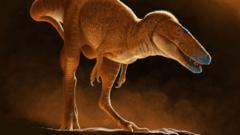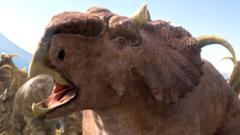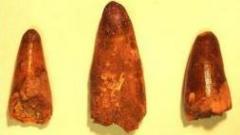"A recent study uncovers teeth marks on a terror bird's leg bone, suggesting it was killed by a gigantic caiman. This discovery sheds light on predator interactions in the ancient ecosystems of Colombia."
"Evidence Unveiled: Ancient 'Terror Bird' Met Its End at the Jaws of Giant Caiman"

"Evidence Unveiled: Ancient 'Terror Bird' Met Its End at the Jaws of Giant Caiman"
"Researchers analyze fossil remains, revealing a deadly encounter between top predators 13 million years ago."
Teeth marks found on the leg bone of a ‘terror bird’ indicate that it may have met a grisly fate at the jaws of a larger predator, a caiman, around 13 million years ago. Once towering over 2.5 meters, these avian giants were formidable hunters, equipped with muscular legs and hooked beaks optimized for ripping flesh. However, a new study by palaeontologists in Colombia, published in the journal Biology Letters, indicates that the terror bird's position as a top predator was challenged by an even deadlier reptilian adversary.
Researchers utilized 3D digital scans to closely examine the arrangement and shape of the teeth marks, drawing comparisons to the skull and dentition of extinct crocodilian species cataloged in museum collections. Their findings suggest a dramatic encounter between two apex predators of their time, marking it as a significant event in the study of ancient food webs.
The fossilized bone, unearthed more than 15 years ago in Colombia’s Tatacoa Desert, dates back to a humid region rich in swamps during the Middle Miocene period. It was discovered by local fossil enthusiast César Augusto Perdomo, whose extensive collection has allowed scientists to deepen their understanding of the extinct fauna inhabiting the area. Upon examination, scientists managed to link the leg bone to the terror bird species and noted the clear incisions left by another powerful predator.
Lead investigator Andres Link from the Universidad de Los Andes noted the absence of healing in the bite marks, implying that the bird likely perished in the violent encounter. "That indicates if it was not dead before the attack occurred, it certainly didn’t survive after," said Link, highlighting the significance of the find — a glimpse into a moment frozen in time where one predator met its end.
The researchers have identified the predator likely responsible as the now-extinct caiman known as Purussaurus neivensis, a formidable creature that could reach lengths of up to five meters. Its predatory behavior likely included stealthily ambushing prey from the water’s edge, a hunting strategy reminiscent of modern crocodiles.
The compelling evidence of active predator interactions also challenges previous assumptions about the terror bird’s vulnerability, suggesting that even large terrestrial predators were not invincible in their ecosystems. "Every piece of a body helps us to understand so much about life on the planet in the past," Link remarked, emphasizing the broader implications of their research. "One tiny bone can complete the story."
As ongoing conversations about extinction and survival continue, this discovery emphasizes the intricate dynamics of prehistoric life and the delicate balance of predator and prey relationships, offering valuable insight into an ancient world, rich with both mighty hunters and lethal dangers.









